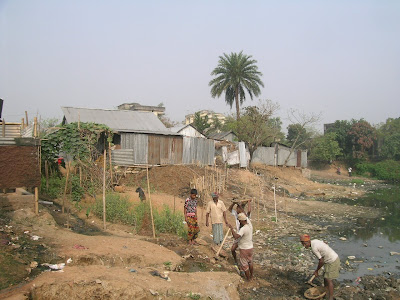
(Mohammad Sujon and Ashan Ullah sitting in their tea shop in Rally Bagan.)
With this blog we are trying to describe the livelihood of slum dwellers in different towns in Bangladesh, including Narayanganj, Jamalpur, Mymensingh and the capital Dhaka. We would like to show you their daily routine, their areas and places of living and to share with you their struggles, their hopes and fears in the hope you realize - like us - that poor people are not just numbers in statistics but human beings.

 (At the entry gate of Patgodam.)
(At the entry gate of Patgodam.) (One of the "main roads" of the settlement.)
(One of the "main roads" of the settlement.) (Shakir Ali, the local leader of the community in his house.)
(Shakir Ali, the local leader of the community in his house.) (One of the few places where the community can get access to drinking water.)
(One of the few places where the community can get access to drinking water.) (Mohammad Hussein's family sitting in their home. From the left: Hira, Mohammad, Liza and her mother.)
(Mohammad Hussein's family sitting in their home. From the left: Hira, Mohammad, Liza and her mother.)
Mohammad’s daughter Liza already realized that the key to escape the slum is education. But in school the young Urdu speakers do not feel fully accepted by their classmates and teachers, the eighteen years old girl tells me. “The Bengalis are not interested in mixing up with us people. Also the teachers are treat us differently,” she says. Her cousin Hira dropped out of school because he did not feel welcome there. Nevertheless, Liza set her priorities and continues to study. She just deals with the situation by staying with her Bihari friends. Apart from going to school she never leaves the slum because especially her mother is afraid of “bad speaking” that could occur. However, to mix up with the Bengalis is not becoming easier this way. But one day she wants to leave the community to study at the Mymensingh University, following her successful brother Raju. He already managed his Engineering diploma (mechanical). But when the family shows me his CV I realize that Bangla and English, but not Urdu is mentioned there as language skill and the address at the head of the document is different from the place in Mymensingh where his family actually lives. “We have to hide our identity, if we want to mix up with the Bengali people. Otherwise they will not accept us,” the father Mohammad Hussein comments.
(From the left: Golati, her son, Bengali neighbour Halimat and her daugther.)
Although the Bihari community here is quite isolated and homogenous there are some Bengalis who are also living here. I meet Golati, who is originally from Sherpur, together with her eldest daughter Mousumi at their place. Golati came here for her love 15 years ago. Because her husband works as an assistant on a bus he is frequently going to Sherpur and met Golati’s brother who has a tea store there. The two men made friendship and Golati got introduced to her husband when he visited her family. After he asked to marry her, she agreed and moved with him to Mymensingh. For her family there was no problem with that. The first two years she felt uncomfortable because she could not speak Urdu and the living conditions were worse than what she was used to. “I feel comfortable now, because it is my husband’s house”, Golati tells, “Because we do not have a better alternative we consider this as a good place.” She thinks that the mix-up between Bengali and Bihari people today is much easier than in the past. For her livelihood that fact does not matter too much. “The relationship with the neighbors is not the problem. We have many other problems: too many kids, bad sanitation and housing conditions and insufficient water supply”, Golati tells me. It appears to me that the conditions of poverty unite people wherever they are from and whatever language they speak.
Some resources for further research in the web:
Many reports and documents on the issue (especially: related High Court decisions) on:http://www.statelesspeopleinbangladesh.net/home.php
Website about a documentary on the Bihari issue from 2007:
http://www.swapnabhumi.com/
"Imperfect World 2009", with special features about the Biharis during the last parliamentary elections:
http://shafiur.i-edit.net/?cat=34

(Saifur, a carpenter from Korail, surrounded by kids on a bamboo platform in the Banani Lake.)


(During the construction process.)
It took three months to finish the construction. Some private businessmen disturbed the process with a claim for the land where the platform was built. “When they saw that we do not want anything commercial, they never came back and we just continued our work after a while”, Kabir says.The purpose of the platform is as a playground for children and a place for people to sit, relax and enjoy the view over Gulshan Lake. At night a few people also sleep here. “Sometimes wedding couples also come here to get themselves photographed with Gulshan in the background”, Kabir tells me.
 (A girl from Korail lounges on the platform, looking at Gulshan.)
(A girl from Korail lounges on the platform, looking at Gulshan.)
I can easily lounge here for a whole Friday afternoon surrounded by kids and other people who are constantly coming and going. I almost forget that the biggest slum in Dhaka is only a stone’s throw away.